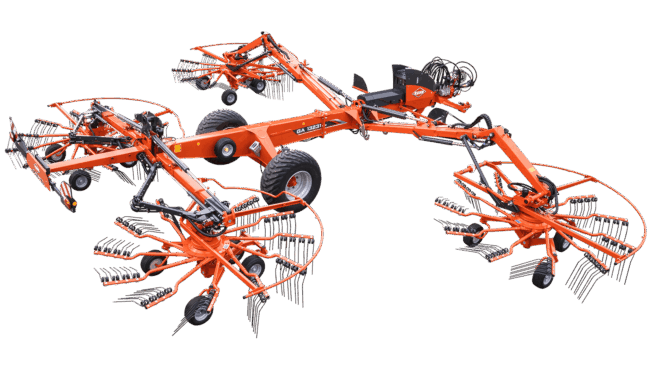
Vierkreiselschwader Serie GA 10231
Vierkreiselschwader GA 13231 und GA 15231 mit Arbeitsbreiten von 8,40 m bis 12,50 m bzw. 9,50 m bis 14.70 m. Der 100% hydraulische Antrieb reduziert den täglichen Wartungsaufwand um 1 Stunde.
Die Vierkreiselschwader GA 13231 und GA 15231 mit Arbeitsbreiten von 8,40 m bis 12,50 m bzw. 9,50 m bis 14,70 m überzeugen durch ihre hohe Arbeitsleistung und -qualität. Der 100% hydraulische Antrieb reduziert durch den Wegfall unzähliger Schmierstellen an Gelenkwellen und Zwischengetrieben den täglichen Wartungsaufwand um 1 Stunde. Diese Zeitersparnis steigert ihre Produktivität um bis zu 10 Hektar pro Tag.
Ihre Vorteile
Eine Stunde weniger Wartung, eine Stunde mehr Schwaden! Der Antrieb der Rotoren erfolgt hydraulisch über Hydraulikpumpen, die über ein einziges Getriebe angetrieben werden. Dies minimiert den Wartungsaufwand erheblich, da das tägliche Abschmieren der Gelenkwellen entfällt. Sie sparen bis zu einer Stunde im Vergleich zu einem mechanisch angetriebenen Schwader derselben Grösse. Dies ist ein erheblicher Vorteile bei steigenden Flächengrössen und kleinen Erntefenstern.
Ein weiterer Vorteile sind der ruhige, leise Betrieb und der geringe Verschleiss. Das Hydraulikaggregat der Schwader GA 13231 und GA 15231 ist am schwenkbaren Anbaubock des Maschinenrahmens positioniert. Damit sind selbst enge Kurvenfahrten problemlos möglich. Darüber hinaus kann die Zapfwellendrehzahl von der Kabine aus verändert werden, um sie perfekt an die Art und Menge des Ernteguts anzupassen.
.jpg)
Mit dem neuen hydraulischen Antrieb und dem noch leistungsfähigeren Kreiselantrieb MASTER DRIVE GIII bewältigt Ihr Schwader grosse Futtermengen und schwierigste Situationen. Die Kraftübertragung wird über ein spielfreies, geradverzahntes Stirnradsystem sichergestellt, das zuverlässig und robust ist.
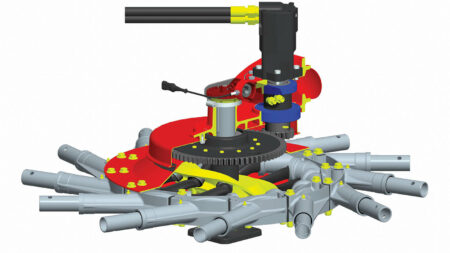
A regular windrow is especially pleasant for drivers of the following harvesting machines. It is most easily collected by pick-ups of crop harvesters, self-loading trailers and balers. Smooth driving means greater comfort! The speed of the front rotors can be increased by 20% compared to the rear rotors. All this without having to move from the tractor cab. The boost function ensures that the crop is moved more towards the centre of the machine. It is less twisted, as it does not roll on the ground. This allows the rear rotors to form a uniform and airy swath. It is an ideal solution for perfect crop drying.
.jpg)
To protect the soil and the plant cover, optimal adaptation of the rotors to the changing terrain is just as important as low ground pressure that limits compaction.
KUHN's four rotor rakes are fully equipped to meet these requirements:
Suspended from the junction of a pivot point and independent of the main frame, the rotors can swivel in all directions thanks to the 3D rotor pendulum joint. They precisely and efficiently follow the variations in the terrain. The result: a flawless performance, the assurance of a clean crop and a healthy plant cover.
The wide tyres help to reduce soil compaction and ensure the stability of the rotors, even on slopes. Stability on slopes is also the strength of the optional radial tyres.
Each rotor is equipped with four pivoting wheels. This ensures that the plant cover is preserved, even in tight turns. Thanks to their position close to the tines, the rotors adapt immediately and efficiently to changes in the terrain.
The front rotors are now suspended by hydraulic cylinders, which allows for a more precise adjustment of the suspension. In addition, the ground pressure is automatically corrected depending on the working width. The user can therefore easily adapt the machine to the working conditions. A hydraulic reduction of the rear rotors is also available as optional equipment. It ensures a load transfer to the machine frame, thereby increasing stability when working on steep slopes. A hydraulic cylinder placed in front of the rotor head controls its lowering. Like an aeroplane, the rear is lowered first, then the front. The tines do not come into contact with the soil thanks to this STABILIFT jet effect.
.jpg)
To protect the soil and the plant cover, optimal adaptation of the rotors to the changing terrain is just as important as low ground pressure that limits compaction.
KUHN's four rotor rakes are fully equipped to meet these requirements:
Suspended from the junction of a pivot point and independent of the main frame, the rotors can swivel in all directions thanks to the 3D rotor pendulum joint. They precisely and efficiently follow the variations in the terrain. The result: a flawless performance, the assurance of a clean crop and a healthy plant cover.
The wide tyres help to reduce soil compaction and ensure the stability of the rotors, even on slopes. Stability on slopes is also the strength of the optional radial tyres.
Each rotor is equipped with four pivoting wheels. This ensures that the plant cover is preserved, even in tight turns. Thanks to their position close to the tines, the rotors adapt immediately and efficiently to changes in the terrain.
The front rotors are now suspended by hydraulic cylinders, which means a more precise adjustment of the suspension. In addition, the ground pressure is automatically corrected depending on the working width. The user can therefore easily adapt the machine to the working conditions. A hydraulic reduction of the rear rotors is also available as optional equipment. It ensures a load transfer to the machine frame, thereby increasing stability when working on steep slopes. A hydraulic cylinder placed in front of the rotor head controls its lowering. Like an aeroplane, the rear is lowered first, then the front. The tines do not come into contact with the soil thanks to this STABILIFT jet effect.
.jpg)
Mit der Section Control-Funktion können Sie das Anheben und
Absenken der Kreisel am Vorgewende automatisieren.
Auf schwierigen Feldern oder in Feldkeilen konzentrieren Sie sich
nur noch auf das Fahren - ein echter Komfortgewinn und eine
echte Produktivitätssteigerung!
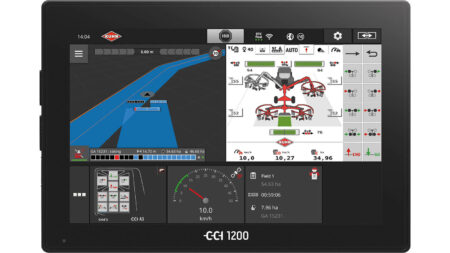
The electronic architecture includes a new ISOBUS module. The latter is more powerful, has more capacity and offers more possibilities. The ISOBUS terminal interface for machine control has been redesigned and is more user-friendly. It is quick and intuitive for the user or their employees to get to grips with the machine. It is also capable of generating graphic icons related to the various functions when using the CCI A3 ISOBUS joystick.
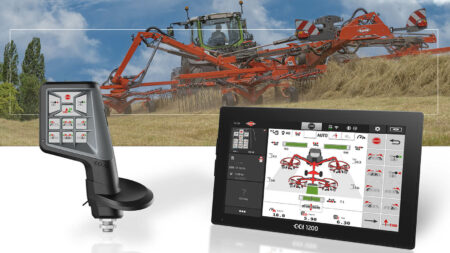
All rotor settings can be adjusted from the control terminal without interrupting work:
- Rotor lift,
- Working and windrow width,
- Individual working width adjustment,
- Rake height,
- Machine folding, etc.
A pre-programmed sequence, integrated into the ISOBUS software, facilitates and optimises turning manoeuvres at the headland. It can be easily adapted to your needs. Thanks to the angle sensors, the rotors are always raised to the preset height, regardless of the working width. Once all the pre-sets have been made, all you have to do is press a button. Sit back and let the electronics do the work!
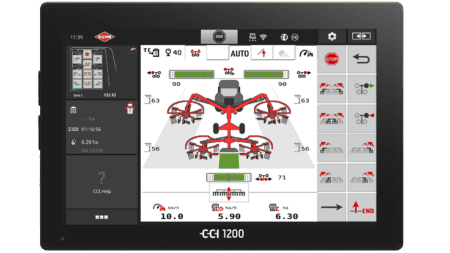
The working widths from 8.40 to 12.50 m and from 9.50 to 14.70 m allow for outstanding yields, which is one of the many benefits of the GA 13231 and GA 15231 rakes.
These large widths require excellent adaptability of the machine to the requirements of the crop harvesters or balers downstream of the harvesting chain. This flexibility allows you to adjust working and windrow widths continuously and hydraulically from the cab:
The position of the front rotors can be adjusted in terms of working width via hydraulic cylinders and angle sensors.
The windrow width can be changed at any time by repositioning the rear rotors. The windrow width is between 1.40 and 2.40 m (and up to 2.50 m with GA 15231).
Despite the large working widths, the four-rotor rakes are flexible enough to work in triangular-shaped fields. The ability to lift each rotor individually allows raking in the tips or avoiding obstacles. In addition, the large clearance under the rotors makes it easier to pass over windrows.
To adjust the raking height, the rotors can be adjusted simultaneously in pairs at the front or rear or individually. The height of the rotors is displayed both on the terminal screen and on the rotor frame.
.jpg)
The hitch with integrated suspension improves driving flexibility and increases stability between the tractor and the rake when turning. Deteriorated roads are no longer a problem. You will appreciate bends and the smooth, individual lifting of the rotors in the lift arms. Despite their impressive dimensions, the four-rotor rakes are relatively compact in transport and easy to move:
In the transport position, the machines reach a height of less than 4.00 m without having to dismantle any tine arms.
Their low centre of gravity ensures good stability on the road.
.jpg)
Spezifikation
| GA 13231 | GA 14231 | GA 15231 | |
|---|---|---|---|
| Arbeitsbreite (m) | 8,40 - 12,50 | 9,00 - 13,70 | 9,50 - 14,70 |
| Mittlere Schwadbreite (m) | 1,40 - 2,40 | 1,40 - 2,50 | 1,40 - 2,50 |
| Transportbreite (m) | 3,00 | 3,00 | 3,00 |
| Transportlänge (m) | 9,95 | 10,30 | 10,90 |
| Transporthöhe (m) | 3,95 | 4,00 | 4 |
| Schwad-Typ | 1 Mittelschwad | 1 Mittelschwad | 1 Mittelschwad |
| Anzahl der Kreisel / Kreiseldurchmesser (m) | 4 / 3,20 | 4 / 3,40 | 4 / 3,65 |
| Anzahl der Zinkenarme pro Kreisel / Anzahl der Doppelzinken pro Zinkenarm | 11 am vorderen Kreisel, 12 am hinteren Kreisel / 4 Doppelzinken pro Zinkenarm | 12 am vorderen Kreisel, 13 am hinteren Kreisel / 4 Doppelzinken pro Zinkenarm | 13 am vorderen Kreisel, 15 am hinteren Kreisel / 4 Doppelzinken pro Zinkenarm |
| Zinkenarme | nicht abnehmbar | nicht abnehmbar | nicht abnehmbar |
| Getriebe-Typ | geschlossenes, wartungsfreies MASTERDRIVE GIII-Getriebe | geschlossenes, wartungsfreies MASTERDRIVE GIII-Getriebe | geschlossenes, wartungsfreies MASTERDRIVE GIII-Getriebe |
| Bodenanpassung | 3D-Pendelaufhängung | 3D-Pendelaufhängung | 3D-Pendelaufhängung |
| Anzahl der Räder pro Kreisel | 4 Schwenkräder pro Kreisel | 4 Schwenkräder pro Kreisel | 4 Schwenkräder pro Kreisel |
| Zinkenhöheneinstellung | hydraulisch (über das Bedienterminal) | hydraulisch (über das Bedienterminal) | hydraulisch (über das Bedienterminal) |
| Entlastung der vorderen Kreisel | konstante, hydraulische Kreiselentlastung; automatische Regelung in Abhängigkeit von Arbeitsbreite | konstante, hydraulische Kreiselentlastung; automatische Regelung in Abhängigkeit von Arbeitsbreite | konstante, hydraulische Kreiselentlastung; automatische Regelung in Abhängigkeit von Arbeitsbreite |
| Einzel-Arbeitsbreitenverstellung der vorderen Kreisel | Serie | Serie | Serie |
| Ersatzrad für Kreiselbereifung | 2, Serie | 2, Serie | 2, Serie |
| Bedienung der Maschine | ISOBUS-Maschine mit Bedienterminal CCI oder ISOBUS-Traktorterminal | ISOBUS-Maschine mit Bedienterminal CCI oder ISOBUS-Traktorterminal | ISOBUS-Maschine mit Bedienterminal CCI oder ISOBUS-Traktorterminal |
| Kreiselantrieb | hydraulischer Kreiselantrieb über im Anbaubock integrierte Bordhydraulik | hydraulischer Kreiselantrieb über im Anbaubock integrierte Bordhydraulik | hydraulischer Kreiselantrieb über im Anbaubock integrierte Bordhydraulik |
| Hauptgelenkwelle | 1 3/8'' - 6 Nuten, ohne Abwinkelungen bei Kurvenfahrten | ohne Abwinkelungen bei Kurvenfahrten | 1 3/8'' - 6 Nuten, ohne Abwinkelungen bei Kurvenfahrten |
| Anbau | gezogen, Unterlenkeranbau Kat. 2 und 3 | gezogen, Unterlenkeranbau Kat. 2 und 3 | gezogen, Unterlenkeranbau Kat. 2 und 3 |
| Leistungsbedarf an der Zapfwelle (kW / PS), ca. | 70 / 95 | 80/105 | 85 / 115 |
| Erforderliche Hydraulikanschlüsse am Traktor | Load-Sensing-Anschluss: 1x Druckleitung, 1x freier Rücklauf, 1x Steuerleitung (LS) | Load-Sensing-Anschluss: 1x Druckleitung, 1x freier Rücklauf, 1x Steuerleitung (LS) | Load-Sensing-Anschluss: 1x Druckleitung, 1x freier Rücklauf, 1x Steuerleitung (LS) |
| Erforderliche Elektroanschlüsse am Traktor | 1 siebenpoliger Elektroanschluss für die Beleuchtungsanlage | 1 siebenpoliger Elektroanschluss für die Beleuchtungsanlage | 1 siebenpoliger Elektroanschluss für die Beleuchtungsanlage |
| Beleuchtungsanlage mit Warntafeln | Serie | Serie | Serie |
| Gewicht (kg), ca. | 5.150 | 5.700 | 6.100 |
| Ausgelieferte Grundmaschine (ohne Sonderausrüstungen) | montierte Maschine | montierte Maschine | montierte Maschine |
.jpg)
.jpg)
.jpg)
.jpg)
.jpg)
.jpg)
.jpg)